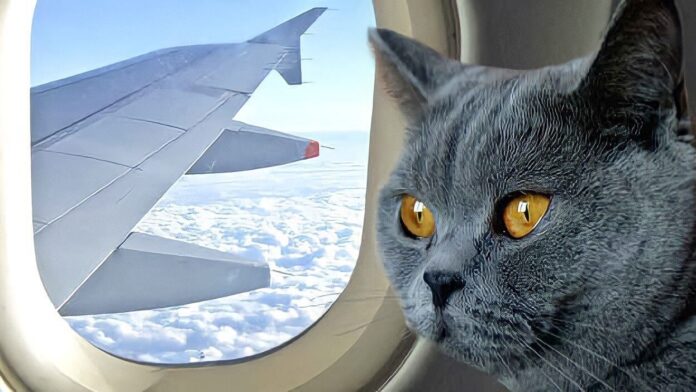Last Updated on August 31, 2023 by Fumipets
A Complete Guide to Flying With Cats on a Plane
Flying with cats on a plane requires careful planning and preparation to ensure the safety and comfort of your feline companion. Cats are generally more sensitive to changes in their environment, so it’s essential to acclimate them to the travel process and follow airline regulations.
Proper carrier choice, familiarization, and consideration of your cat’s health and temperament are key factors to a successful and stress-free flying experience for both you and your cat.
Flying With Cats on a Plane
You can’t picture leaving your greatest furry buddy behind when it’s time to go for a long period of time to see family abroad or across the nation. We consider our dogs to be members of our family, and if we could, we would take them almost anywhere. It’s important to prepare in advance if you intend to take your beloved pet with you on a flight.
Despite the fact that you may usually fly with a cat, you should always respect the rules of the airline and make sure your feline companion is as comfortable as possible. Additionally, if you’re going abroad, you need to be aware of the rules in that country for transporting a live animal there. To receive the finest guidance, we talked with vets. Take this as your safety manual for traveling with a cat.
Can You Fly With Your Cat on a Plane?
You certainly can! But before you pack them up and go to the airport, you’ll need to complete your homework. A health certificate is normally necessary for domestic travel, typically within 10 days of flight. With the help of this health certificate, you can confirm that your cat is at least eight weeks old, fully vaccinated, and clear of any infectious illness symptoms.
Even while you can travel by airline with your cat, it’s not always the greatest choice for cats. It’s OK if the cat is ok with traveling, doesn’t mind being in a travel cage or bag, and is ok in unfamiliar environments, but if the cat doesn’t enjoy those things—which is likely to be the case for most cats—a pet sitter is preferable.
It can be advisable to leave your cat at home with a dependable relative, friend, or pet sitter if they see indications of tension or anxiety in your cat, such as excessive vocalization, excessive grooming, or drooling.
How to Fly With Your Cat Internationally
There will be more obstacles to overcome if you plan to travel abroad. Despite comparable laws, other places would demand different vaccinations due to health concerns like parasite control. These paperwork may be many pages long and must normally be completed by a veterinarian who has obtained USDA certification. Before traveling, certain places can demand rabies titers, which might take months to process.
It’s crucial to keep in mind that these rules are also subject to modification, so for the most recent information regarding your location, be sure to visit the USDA website for Pet Travel. Give the process of negotiation plenty of time. There could be businesses in your neighborhood that provide a paid service to guide you through this system.

Each Airline Has a Different Pet Travel Policy
How about the air carriers? Almost all airlines let cats travel with their owners. However, many airlines have limits on the number of dogs that can board an aircraft, so you should make your reservations in advance to avoid any issues at check-in. Since booking online isn’t always a possibility, you often need to phone the airlines in order to do this.
You must ensure that your luggage complies with the requirements because each airline has different weight and size restrictions for pet carriers. Most of the time, your cat must be able to spend the entire trip in their carrier in front of your seat without feeling uncomfortable.
It is advised to plan non-stop flights to minimize your cat’s overall travel time and associated stress. You should also be aware that your pet qualifies as a carry-on, necessitating the checking of an additional bag to hold your things. Be warned that you won’t be able to bring your cat and seat in an exit row.
Here are some instances of popular airlines and their rules for pet carriers:
- Alaskan Airlines: Hard-sided dimensions: 17″L x 11″W x 7.5″H; Soft-sided dimensions 17″L x 11″W x 9.5″H
- American Airlines: Carrier must be able to fit under the seat in front of you. The combined weight of the carrier and your pet can’t exceed 20 pounds.
- Delta Airlines: Carrier must be able to fit under the seat in front of you.
- JetBlue: Carrier dimensions: 17″L x 12.5″W x 8.5″H. The combined weight of your pet and the carrier must not exceed 20 pounds.
- United: Hard-sided carrier dimensions: 17.5″L x 12″W x 7.5″H; Soft-sided carrier dimensions 18″L x 11″W x 11″H.
How Much Does It Cost to Fly With a Cat on a Plane?
Cat ownership requires a 15–20-year commitment. This involves not only providing your cat with tons of love and attention, but also entails financial obligations. Airlines charge a cost for every flight, so taking a cat along on a flight isn’t free. As we previously noted, you’ll also probably have to pay for a checked bag, which may cost anywhere between $20 and $40 depending on the airline because your cat qualifies as your carry-on.
These prices are subject to change, so confirm them before making your reservation with one of these top five airlines:
- Alaskan Airlines: $100 per flight
- American Airlines: $125 per flight
- Delta Airlines: $125 per flight
- JetBlue: $125 per flight
- United: $125 per flight
6 Tips for Flying With a Cat Safely
It should be as simple and comfy as possible for you and your beloved small cat to go from point A to point B. There are several things you can do to get ready for the experience even though, of course, you may have to deal with numerous meows and some fears. These top advice from vets will facilitate a smooth encounter.
1. Be prepared for security.
In an ideal scenario, you wouldn’t need to remove your cat from its carrier until you’ve reached your destination without incident. Unfortunately, that isn’t an option since security checks require you to remove your pet’s bag so the carrier may be scanned in the X-ray. As a result, you will have to go through the metal detectors with your cat. Sheen advises securing your cat with a leash and a well-fitting harness to prevent escape.
2. Consider a soft-sided travel carrier.
For cabin travel, several airlines accept either a soft-sided or a hard-sided carrier. Sheen claims that the soft-sided carrier, however, might be more forgiving and offer your cat a little more room to turn around and get comfy. So if you’re having trouble deciding, think about which option will make your pet feel the most comfortable.
3. Make the carrier a happy place.
Since your feline travel partner will spend practically all of the time in the carrier, it’s essential to make it as cozy as possible. Include things that make them think of home, like their favorite toy, an old T-shirt, or a cozy blanket. In order to help them feel more at ease within their carrier, you may also apply a feline pheromone spray like Feliway.
Additionally, remember to get your carrier at least a few weeks before your vacation so you can ease your cat into using it. As a result, they might become accustomed to it and lose their dread. Leave it outside so they may sniff it, examine it, and maybe even take a nap there. Start taking them for walks in the carrier as they progressively warm up, and then take them on short drives. When it’s time to leave for your flight, keep those familiar goods in their container.

4. Pack essentials.
When traveling with cats, it’s better to be over-prepared in case of mishaps or emergencies. Leash, harness, collapsible bowl, wipes, and treats should all be brought along. The majority of carriers will include a place to put these things, but keep food and liquids separate to prevent spillage. It’s crucial to correctly identify your carrier by including your name, contact information, and destination location.
5. Avoid feeding the morning of travel.
Even though it can sound cruel, it could be preferable to skip feeding your cat the morning of the flight. Why is that? It’s preferable for cats to have less food in their stomachs since some cats may feel nausea and vomiting. Of course, you still need to make sure they’re hydrated! If there are any accidents, line the carrier with an absorbent pad, such as a puppy potty pad.
6. Talk to your vet about medication.
Although the majority of cats do not require medication, it could be wise if your cat has extreme anxiety. Sheen advises consulting your veterinarian, who can provide advice on whether prescription sedatives are required for your journey. You should make sure your cat is safe before utilizing them because they do pose health hazards.
Q&A about Flying With Cats on a Plane:
1. Can I fly with my cat in the cabin?
Many airlines allow cats to fly in the cabin, but there are restrictions on carrier size and other guidelines. Check with the airline beforehand to understand their specific rules and requirements.
2. How should I choose the right carrier for my cat?
Select a well-ventilated, sturdy carrier that is large enough for your cat to stand, turn around, and lie down comfortably. Make sure it’s compliant with airline regulations.
3. How can I prepare my cat for air travel?
Gradually introduce your cat to the carrier by letting them explore it at home and associating it with positive experiences. Familiarize them with car rides and short trips to ease them into the travel experience.
4. Is sedation a good option for flying with cats?
Sedating cats for air travel is generally not recommended, as it can lead to adverse effects at high altitudes. Consult your veterinarian for safe alternatives to reduce anxiety and stress.
5. What health considerations should I keep in mind?
Ensure your cat is up-to-date on vaccinations and has a recent health check-up before flying. Some airlines require a health certificate issued by a veterinarian within a certain timeframe before the flight.


















